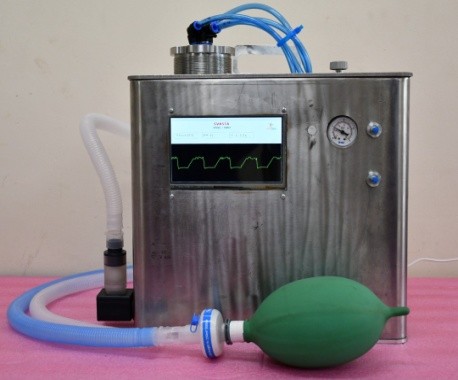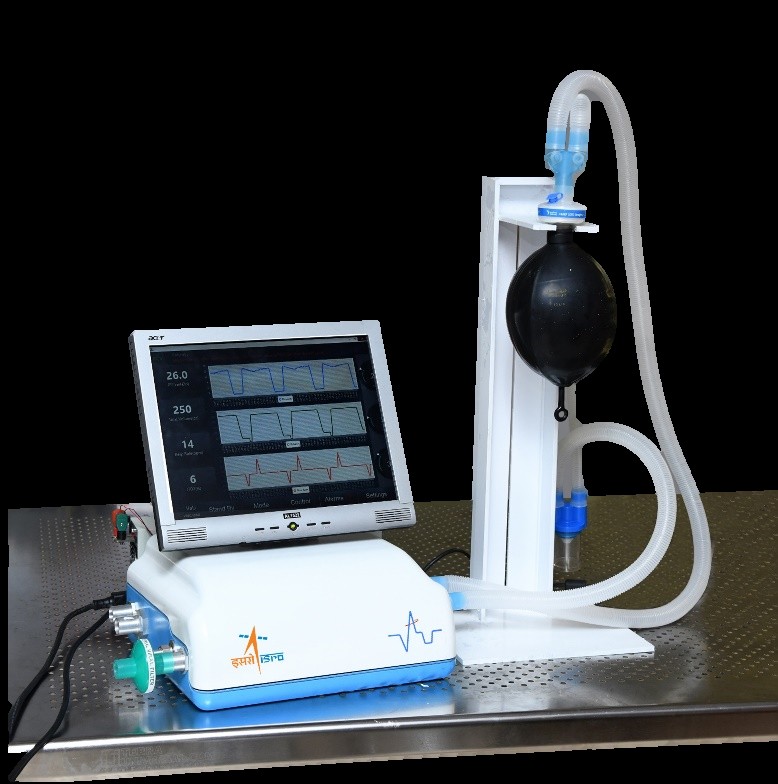Ventilators developed by VSSC
SVASTA (Space Ventilated Assisted System for Trauma Aid)
 All the ventilator parameters are manually adjustable and hence this ventilator does not require
electric power for its operation. A display is provided to view the ventilation parameters.
It is a gas-powered mechanical ventilator working on pneumatically operated double acting
piston-cylinder. It has valves that cyclically pressurises and vents the opposite sides of the
piston to achieve the reciprocating motion of the piston. The tidal volume delivered per breath depends on the
length of the control chamber which is manually adjustable using a sweep adjuster. Various inspiration and explanation times are achieved by selecting
different orifice diameters
through manual flow control valves.
All the ventilator parameters are manually adjustable and hence this ventilator does not require
electric power for its operation. A display is provided to view the ventilation parameters.
It is a gas-powered mechanical ventilator working on pneumatically operated double acting
piston-cylinder. It has valves that cyclically pressurises and vents the opposite sides of the
piston to achieve the reciprocating motion of the piston. The tidal volume delivered per breath depends on the
length of the control chamber which is manually adjustable using a sweep adjuster. Various inspiration and explanation times are achieved by selecting
different orifice diameters
through manual flow control valves.
VaU (Ventilation Assist Unit)
 Ventilation assist Unit, abbreviated as VaU is a centrifugal blower based ICU Grade positive pressure mechanical ventilation system
At the heart of the VaU system is a BLDC motor
driven centrifugal blower that draws in filtered ambient air through an inlet manifold that houses a Bacterial
Viral Filter. Provision is also given in the inlet manifold to connect low pressure medical oxygen, for the control
of the Fraction of Inspired Oxygen (FiO2). The device is capable of working in various ventilation modes such as
PC, VC, PC-SIMV, VC-SIMV, PRVC, PSV etc. An integrated touch screen display has also been provided in VaU
for the adjustment and monitoring of
the respiration parameters.
Ventilation assist Unit, abbreviated as VaU is a centrifugal blower based ICU Grade positive pressure mechanical ventilation system
At the heart of the VaU system is a BLDC motor
driven centrifugal blower that draws in filtered ambient air through an inlet manifold that houses a Bacterial
Viral Filter. Provision is also given in the inlet manifold to connect low pressure medical oxygen, for the control
of the Fraction of Inspired Oxygen (FiO2). The device is capable of working in various ventilation modes such as
PC, VC, PC-SIMV, VC-SIMV, PRVC, PSV etc. An integrated touch screen display has also been provided in VaU
for the adjustment and monitoring of
the respiration parameters.
PRANA (Programmable Respiratory Assistance for the Needy Aid)
 PRANA is a low-cost and portable critical care ventilator. The ventilator is based on the
automated compression of an Artificial Manual Breathing Unit (AMBU) bag.
The drive unit is an automobile wiper DC motor
connected to a gear train. The gears in turn drive the hand like structures which compresses the AMBU
bag held between them. The system has a sophisticated control system that includes
airway pressure sensor, flow sensor, oxygen sensor, servo actuator as well as expiration and Positive End Expiratory
Pressure (PEEP)
control valves. PRANA is capable of
giving mandatory breaths (controlled by ventilator) as well as spontaneous breaths (controlled by
the patient). The clinicians can select the ventilation mode and set the required parameters through
a touch screen panel and monitor various parameters like pressure, flow, tidal volume, oxygen
concentration, etc. on the same screen. The ventilator can deliver the required flow of oxygen-air
mixture to the patient’s lung at a desired rate set by the clinicians. A robust algorithm for controlled
and safe ventilation of the patient is implemented which raises alarm and opens safety valves to prevent
barotrauma, asphyxia and apnea during the ventilation. Alarm is also raised in case of wrong or improper
connection of the ventilation circuit or inadvertent disconnection of the hose or sensors. There are also
provisions to attach bacterial viral filters at each interface to prevent cross-infection and the
contamination of air. It also has a provision to attach external battery for backup during power failure.
PRANA is a low-cost and portable critical care ventilator. The ventilator is based on the
automated compression of an Artificial Manual Breathing Unit (AMBU) bag.
The drive unit is an automobile wiper DC motor
connected to a gear train. The gears in turn drive the hand like structures which compresses the AMBU
bag held between them. The system has a sophisticated control system that includes
airway pressure sensor, flow sensor, oxygen sensor, servo actuator as well as expiration and Positive End Expiratory
Pressure (PEEP)
control valves. PRANA is capable of
giving mandatory breaths (controlled by ventilator) as well as spontaneous breaths (controlled by
the patient). The clinicians can select the ventilation mode and set the required parameters through
a touch screen panel and monitor various parameters like pressure, flow, tidal volume, oxygen
concentration, etc. on the same screen. The ventilator can deliver the required flow of oxygen-air
mixture to the patient’s lung at a desired rate set by the clinicians. A robust algorithm for controlled
and safe ventilation of the patient is implemented which raises alarm and opens safety valves to prevent
barotrauma, asphyxia and apnea during the ventilation. Alarm is also raised in case of wrong or improper
connection of the ventilation circuit or inadvertent disconnection of the hose or sensors. There are also
provisions to attach bacterial viral filters at each interface to prevent cross-infection and the
contamination of air. It also has a provision to attach external battery for backup during power failure.